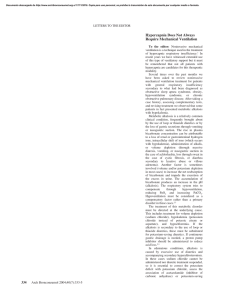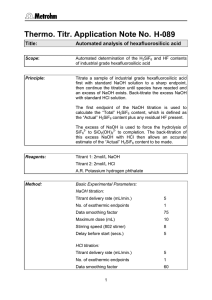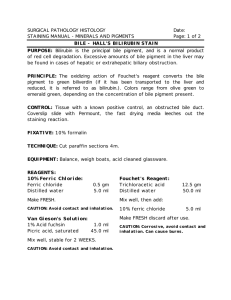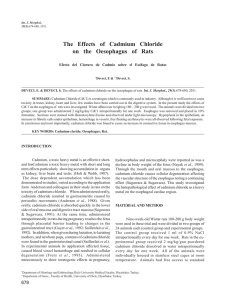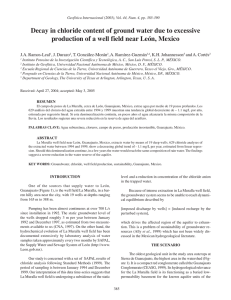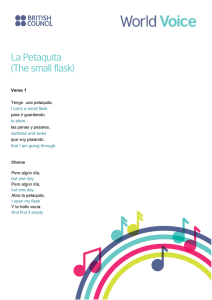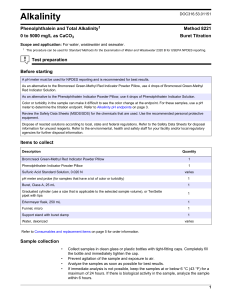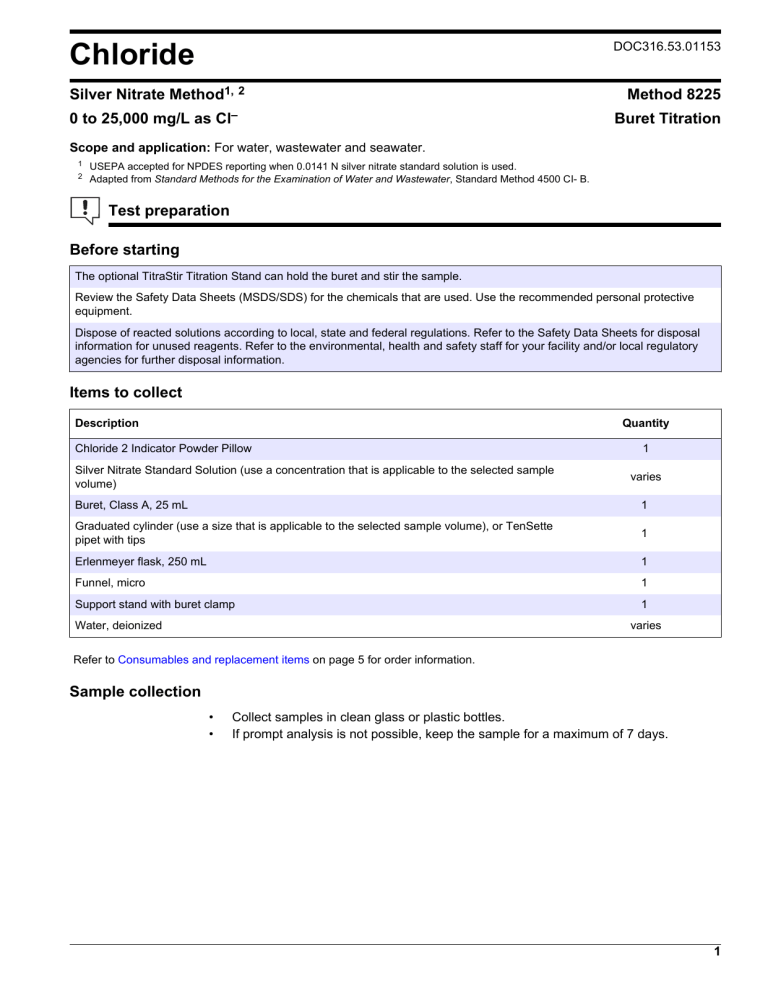
Chloride DOC316.53.01153 Silver Nitrate Method1, 2 0 to 25,000 mg/L as Cl– Method 8225 Buret Titration Scope and application: For water, wastewater and seawater. 1 2 USEPA accepted for NPDES reporting when 0.0141 N silver nitrate standard solution is used. Adapted from Standard Methods for the Examination of Water and Wastewater, Standard Method 4500 CI- B. Test preparation Before starting The optional TitraStir Titration Stand can hold the buret and stir the sample. Review the Safety Data Sheets (MSDS/SDS) for the chemicals that are used. Use the recommended personal protective equipment. Dispose of reacted solutions according to local, state and federal regulations. Refer to the Safety Data Sheets for disposal information for unused reagents. Refer to the environmental, health and safety staff for your facility and/or local regulatory agencies for further disposal information. Items to collect Description Quantity Chloride 2 Indicator Powder Pillow Silver Nitrate Standard Solution (use a concentration that is applicable to the selected sample volume) 1 varies Buret, Class A, 25 mL 1 Graduated cylinder (use a size that is applicable to the selected sample volume), or TenSette pipet with tips 1 Erlenmeyer flask, 250 mL 1 Funnel, micro 1 Support stand with buret clamp 1 Water, deionized varies Refer to Consumables and replacement items on page 5 for order information. Sample collection • • Collect samples in clean glass or plastic bottles. If prompt analysis is not possible, keep the sample for a maximum of 7 days. 1 Test procedure 1. Select a sample volume and titrant from Table 1 on page 3. 2. Fill a 25-mL buret to the zero mark with the titrant. 3. Use a graduated cylinder or pipet1 to measure the sample volume from Table 1 on page 3. 4. Pour the sample into a clean, 250-mL Erlenmeyer flask. 5. If the sample volume is less than 100 mL, dilute to approximately 100 mL with deionized water. 6. Add the contents of one Chloride 2 Indicator Powder Pillow. 7. Swirl to mix. 8. Put the flask under the buret. Swirl the flask. Add titrant until the color changes from yellow to redbrown. 9. Use the multiplier in Table 1 on page 3 to calculate the concentration. mL of titrant × multiplier = mg/L as Cl–. Sample volumes and multipliers Select a range in Table 1, then read across the table row to find the applicable information for this test. Use the multiplier to calculate the concentration in the test procedure. 1 2 Titration accuracy has a direct relation to the accuracy of the sample volume measurement. For smaller volumes, it is recommended to use a pipet to increase accuracy. Chloride (25,000 mg/L) Example: A 100-mL sample was titrated with 0.0141 N titrant and 12 mL of titrant was used at the endpoint. The concentration is 12 mL × 5 = 60 mg/L as Cl–. Table 1 Sample volumes and multipliers Range (mg/L) Sample volume (mL) Titrant—silver nitrate Multiplier 0–125 100 0.0141 N 5 100–250 50 0.0141 N 10 200–500 25 0.0141 N 20 500–1250 100 0.141 N 50 1000–2500 50 0.141 N 100 2500–10,000 25 0.141 N 200 5000–25,000 10 0.141 N 500 Conversions To change the units or chemical form of the test result, multiply the test result by the factor in Table 2. Table 2 Conversions mg/L chloride (Cl–) to... mg/L sodium chloride (NaCl) meq/L chloride (Cl–) multiply by... Example 1.65 1000 mg/L chloride x 1.65 = 1650 mg/L NaCl 0.02821 1000 mg/L chloride x 0.02821 = 28.21 meq/L Cl– Interferences Interfering substance Interference level Bromide Interferes directly and is included in the test result. Cyanide Interferes directly and is included in the test result. Iodide Interferes directly and is included in the test result. Iron Concentrations that are more than 20 mg/L prevent the color change at the endpoint. Orthophosphate Concentrations that are more than 25 mg/L cause a precipitate to form. Highly buffered samples or extreme sample pH Can prevent the correct pH adjustment (of the sample) by the reagents. Sample pretreatment may be necessary. Adjust strongly alkaline or acidic samples to a pH of 7 to 9 with 5.25 N sulfuric acid or 5.0 N sodium hydroxide. Do not use a pH meter directly for the pH adjustment because the pH electrode will contaminate the sample. Collect a separate sample to find the correct quantity of acid or base to add. Then, add the same quantity of acid or base to the sample that is used in the test procedure. As an alternative, use pH paper to measure the pH. Sulfide Remove sulfide interference as follows: 1. 2. 3. 4. Sulfite Add the contents of one Sulfide Inhibitor Reagent Powder Pillow to approximately 125 mL of sample. Mix for 1 minute. Pour the solution through folded filter paper in a funnel. Use the filtered sample in the chloride test procedure. Concentrations that are more than 10 mg/L interfere with this method. To remove sulfite interference, add 3 drops of 30% Hydrogen Peroxide to the sample, then start the test. Accuracy check Standard additions method (sample spike)—0.0141 N titrant Use the standard additions method to validate the test procedure, reagents, apparatus, technique and to find if there is an interference in the sample. Chloride (25,000 mg/L) 3 Items to collect: • • • Chloride Voluette Ampule Standard Solution, 12,500-mg/L Cl– Ampule Breaker Pipet, TenSette, 0.1–1.0 mL and pipet tips 1. Use the test procedure to measure the concentration of the standard solution. Use the 0.0141 N titrant. 2. Use a TenSette pipet to add 0.1 mL of the standard solution to the titrated sample. 3. Titrate the spiked sample to the endpoint. Record the mL of titrant added. 4. 5. 6. 7. 8. Add one more 0.1-mL addition of the standard solution to the titrated sample. Titrate the spiked sample to the endpoint. Record the mL of titrant added. Add one more 0.1-mL addition of the standard solution to the titrated sample. Titrate the spiked sample to the endpoint. Record the mL of titrant added. Compare the actual result to the correct result. The correct result for this titration is 2.5 mL of titrant for each 0.1-mL addition of the standard solution. If much more or less titrant was used, there can be a problem with user technique, reagents, apparatus or an interference. Standard additions method (sample spike)—0.141 N titrant Use the standard additions method to validate the test procedure, reagents, apparatus, technique and to find if there is an interference in the sample. Items to collect: • • • Chloride Voluette Ampule Standard Solution, 12,500-mg/L Cl– Ampule Breaker Pipet, TenSette, 0.1–1.0 mL and pipet tips 1. Use the test procedure to measure the concentration of the standard solution. Use the 0.141 N titrant. 2. Use a TenSette pipet to add 1.0 mL of the standard solution to the titrated sample. 3. Titrate the spiked sample to the endpoint. Record the mL of titrant added. 4. Add one more 1.0-mL addition of the standard solution to the titrated sample. 5. Titrate the spiked sample to the endpoint. Record the mL of titrant added. 6. Add one more 1.0-mL addition of the standard solution to the titrated sample. 7. Titrate the spiked sample to the endpoint. Record the mL of titrant added. 8. Compare the actual result to the correct result. The correct result for this titration is 2.5 mL of titrant for each 1.0-mL addition of the standard solution. If much more or less titrant was used, there can be a problem with user technique, reagents, apparatus or an interference. Titrant test—0.0141 N titrant Examine the strength of the Silver Nitrite Standard Solution each month. The strength of Sodium Hydroxide Standard Solution slowly decreases in light. Items to collect: • • • Sodium Chloride Standard Solution, 1000 mg/L as Cl– 100-mL Class A volumetric flask 250-mL Erlenmeyer flask 1. Add 10.0 mL of Sodium Chloride Standard Solution (as 1000-mg/L as Cl–) to a 100mL Class A volumetric flask. 2. Dilute the standard solution to approximately 100 mL with deionized water. 3. Add 100.0 mL of the diluted standard solution (100-mg/L as Cl–) to a 250-mL Erlenmeyer flask. 4 Chloride (25,000 mg/L) 4. Add one Chloride 2 Indicator Powder Pillow to the flask. 5. Titrate the solution to the endpoint with the 0.0141 N titrant. Record the mL of titrant added. 6. If more than 21 mL of titrant was added (test result = 105 mg/L chloride), discard the titrant. Get new titrant. Titrant test—0.141 N titrant Examine the strength of the 0.141 N Silver Nitrite Standard Solution each month. The strength of Sodium Hydroxide Standard Solution slowly decreases in light. Items to collect: • • Sodium Chloride Standard Solution, 1000 mg/L as Cl– 250-mL Erlenmeyer flask 1. Add 100.0 mL of Sodium Chloride Standard Solution (as 1000-mg/L as Cl–) to a 250mL Erlenmeyer flask. 2. Add one Chloride 2 Indicator Powder Pillow to the flask. 3. Titrate the solution to the endpoint with the 0.141 N titrant. Record the mL of titrant added. 4. If more than 21 mL of titrant was added (test result = 1050 mg/L chloride), discard the titrant. Get new titrant. Summary of Method Silver nitrate is used as the titrant and potassium chromate as the indicator. Silver nitrate first reacts selectively with the chloride in the sample to make insoluble white silver chloride. After all the chloride has precipitated, the silver nitrate reacts with the chromate to form an orange or red-brown silver chromate precipitate. Consumables and replacement items Required reagents Description Quantity/Test Unit Item no. 1 pillow 50/pkg 105766 Silver Nitrate Standard Solution, 0.0141 N varies 1L 31653 Silver Nitrate Standard Solution, 0.141 N varies 500 mL 1255149 Water, deionized varies 4L 27256 Quantity/test Unit Item no. Buret clamp, double 1 each 32800 Buret, Class A, 25 mL 1 each 2636540 Support stand 1 each 56300 Funnel, micro 1 each 2584335 Cylinder, graduated, 5 mL 1 each 50837 Cylinder, graduated, 10 mL 1 each 50838 Cylinder, graduated, 25 mL 1 each 50840 Cylinder, graduated, 50 mL 1 each 50841 Cylinder, graduated, 100 mL 1 each 50842 Chloride 2 Indicator Powder Pillows Required apparatus Description Graduated cylinders—Select one or more for the sample volume: Chloride (25,000 mg/L) 5 Required apparatus (continued) Description Quantity/test Unit Item no. 1 each 1970001 varies 50/pkg 2185696 1 each 1970010 varies 50/pkg 2199796 1 each 50546 Unit Item no. 16/pkg 1425010 500 mL 18349 Unit Item no. each 2196800 12/pkg 2087076 each 96800 Dropper, LDPE, 0.5 –1.0 mL 20/pkg 2124720 Filter paper, folded, 3–5-micron, 12.5-cm 100/pkg 69257 Flask, volumetric, Class A, 100-mL each 1457442 Funnel, poly, 65 mm each 108367 Hydrogen Peroxide Solution, 30%, ACS 473 mL 14411 Paper, pH, 0–14 pH range 100/pkg 2601300 100 mL MDB 245032 Sulfide Inhibitor Reagent Powder Pillows 100/pkg 241899 Sulfuric Acid Standard Solution, 5.25 N 100 mL 244932 Stir bar, octagonal each 2095352 TitraStir® Titration Stand, 115 VAC each 1940000 TitraStir® Titration Stand, 230 VAC each 1940010 ® Tensette pipets and pipet tips—Select one or more for the sample volume: ® Pipet, TenSette , 0.1–1.0 mL ® Pipet tips, TenSette Pipet, 0.1–1.0 mL ® Pipet, TenSette , 1.0–10.0 mL ® Pipet tips, TenSette Pipet, 1.0–10.0 mL Flask, Erlenmeyer, 250 mL Recommended standards Description Chloride Standard Solution, 12,500 mg/L as Cl–, 10-mL Voluette ampules Sodium Chloride Standard Solution, 1000-mg/L as Cl– Optional reagents and apparatus Description ® Ampule Breaker, 10-mL Voluette Ampules Bottle, sampling, with cap, low density polyethylene, 250 mL Clippers Sodium Hydroxide Standard Solution, 5.0 N FOR TECHNICAL ASSISTANCE, PRICE INFORMATION AND ORDERING: In the U.S.A. – Call toll-free 800-227-4224 Outside the U.S.A. – Contact the HACH office or distributor serving you. On the Worldwide Web – www.hach.com; E-mail – [email protected] © Hach Company/Hach Lange GmbH, 2007–2015. All rights reserved. HACH COMPANY WORLD HEADQUARTERS Telephone: (970) 669-3050 FAX: (970) 669-2932 05/2015, Edition 8

